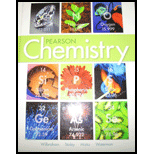
a)
Interpretation: The boiling of water should be classified as a physical or chemical change.
Concept Introduction: A change that affects the chemical composition of a substance is said to be a chemical change whereas a change that affects the form of a substance but not its chemical composition is said to be a physical change.
a)
Answer to Problem 36LC
Physical change.
Explanation of Solution
During the boiling of water, the change in phase takes place, water changes its phase from liquid to a gaseous state. In this process, there is no change in the chemical composition of water and thus, it is a physical change.
b)
Interpretation: The salt dissolved in water should be classified as physical or chemical change.
Concept Introduction: A change that affects the chemical composition of a substance is said to be a chemical change whereas a change that affects the form of a substance but not its chemical composition is said to be a physical change.
b)
Answer to Problem 36LC
Chemical change.
Explanation of Solution
When salt is dissolved in water it results in the dissociation of salt into its constituent ions. In this process, there is a change in the chemical composition of salt and thus, it is a chemical change.
c)
Interpretation: The turning of milk into sour should be classified as a physical or chemical change.
Concept Introduction: A change that affects the chemical composition of a substance is said to be a chemical change whereas a change that affects the form of a substance but not its chemical composition is said to be physical.
c)
Answer to Problem 36LC
Chemical change.
Explanation of Solution
The turning of milk into sour results in the formation of lactic acid from lactose, a sugar found in milk. In this process, there is a change in the chemical composition of milk and thus, it is a chemical change.
d)
Interpretation: The rusting of metal should be classified as physical or chemical change.
Concept Introduction: A change that affects the chemical composition of a substance is said to be a chemical change whereas a change that affects the form of a substance but not its chemical composition is said to be a physical change.
d)
Answer to Problem 36LC
Chemical change.
Explanation of Solution
During rusting of iron, the iron and oxygen molecules react to make a new compound, iron oxide. In this process, there is a change in the chemical composition of iron and thus, it is a chemical change.
Chapter 2 Solutions
Chemistry 2012 Student Edition (hard Cover) Grade 11
- Why does the anhydride react with the OH on the benzene rather than the OH on the carboxy group?arrow_forwardAnswer the followings: 1- What is the IP for a amino acid? Give example. 2- What are the types of amino acids? 3- What are the structures of protein? 4- The N-Terminal analysis by the Edman method shows saralasin contains sarcosine at the N- terminus. Partial hydrolysis of saralasin with dilute hydrochloric acid yields the following fragments: Tyr-Val-His Sar-Arg-Val His-Pro-Ala Val-Tyr-Val Arg-Val-Tyr What is the structure of saralasin? 5. MATCH a term from the list below to each definition. Place the letter of the term in the blank to the left of the definition. a. Ligases b. Fibrous proteins c. Conjugated protein d. Hydrolases a. b. C. e. Simple protein f. Globular proteins g. Lyases h. Transferases Proteins that are tough and insoluble in water. Enzymes that catalyze the breaking away of a small molecule such as from a substrate. Enzymes that catalyze the bonding together of two substrates.arrow_forwardAnswer the followings (Four): 1-What is the difference(s) between FOUR: a. Glyceride and phosphoglyceride. b. Wax and fat. c. Soap and fatty acid. d. HDL and LDL cholesterol e. Phospho lipids and sphingosine. 2-What are the types of lipids? 3-What are the main lipid components of membrane structures? 4-How could lipids play important rules as signaling molecules and building units? 5. The Structure variety of Lipids makes them to play significant rules in our body. Conclude briefly on this statement.arrow_forward
 ChemistryChemistryISBN:9781305957404Author:Steven S. Zumdahl, Susan A. Zumdahl, Donald J. DeCostePublisher:Cengage Learning
ChemistryChemistryISBN:9781305957404Author:Steven S. Zumdahl, Susan A. Zumdahl, Donald J. DeCostePublisher:Cengage Learning ChemistryChemistryISBN:9781259911156Author:Raymond Chang Dr., Jason Overby ProfessorPublisher:McGraw-Hill Education
ChemistryChemistryISBN:9781259911156Author:Raymond Chang Dr., Jason Overby ProfessorPublisher:McGraw-Hill Education Principles of Instrumental AnalysisChemistryISBN:9781305577213Author:Douglas A. Skoog, F. James Holler, Stanley R. CrouchPublisher:Cengage Learning
Principles of Instrumental AnalysisChemistryISBN:9781305577213Author:Douglas A. Skoog, F. James Holler, Stanley R. CrouchPublisher:Cengage Learning Organic ChemistryChemistryISBN:9780078021558Author:Janice Gorzynski Smith Dr.Publisher:McGraw-Hill Education
Organic ChemistryChemistryISBN:9780078021558Author:Janice Gorzynski Smith Dr.Publisher:McGraw-Hill Education Chemistry: Principles and ReactionsChemistryISBN:9781305079373Author:William L. Masterton, Cecile N. HurleyPublisher:Cengage Learning
Chemistry: Principles and ReactionsChemistryISBN:9781305079373Author:William L. Masterton, Cecile N. HurleyPublisher:Cengage Learning Elementary Principles of Chemical Processes, Bind...ChemistryISBN:9781118431221Author:Richard M. Felder, Ronald W. Rousseau, Lisa G. BullardPublisher:WILEY
Elementary Principles of Chemical Processes, Bind...ChemistryISBN:9781118431221Author:Richard M. Felder, Ronald W. Rousseau, Lisa G. BullardPublisher:WILEY





